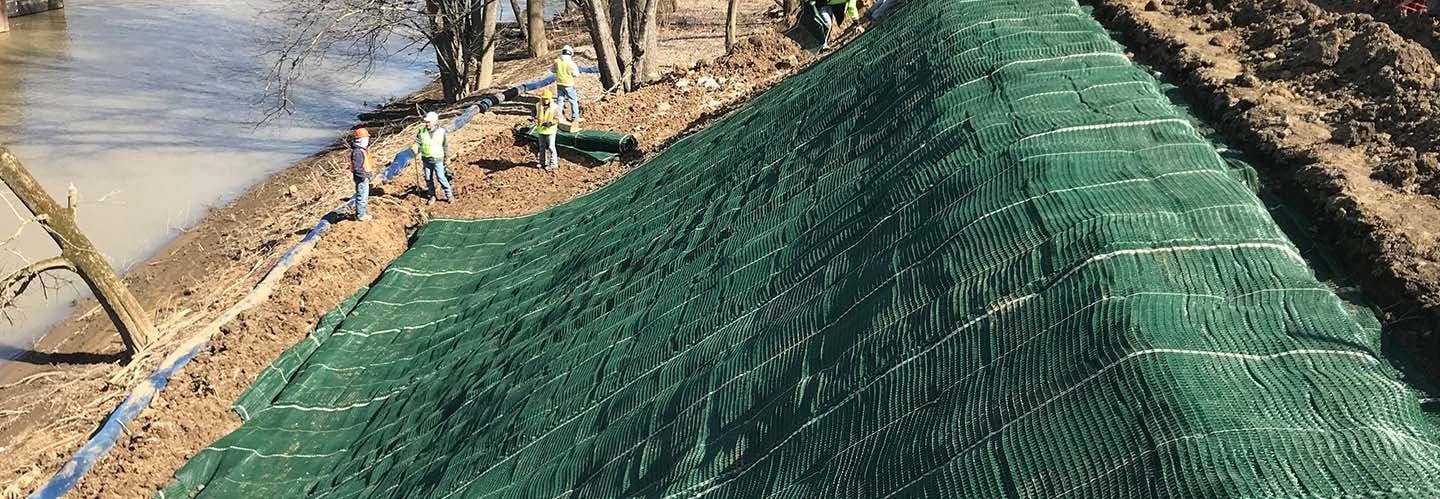Stabilizing the Eroding Monogahela Riverbank
Posted on 9.30.2021 by Kathryn Grant
“Where banks cave in or erode,” this is the translation of the Lenape word Mënaonkihëla. It is also the namesake for the Monogahela River, which flows through southwest Pennsylvania. The river earned this name because of the geological instability of its banks.
Despite its forbidding name, the Monogahela has become home to a number of industrial facilities, including Univar Solutions. Univar operates a chemical distribution facility in Bunola, PA, using the river as the main transportation hub. The facility includes a dock where barges routinely deliver materials. Adjacent to the dock is a slope that had been experiencing translational slope failures, which were putting the dock and the facility’s piping infrastructure at risk. Additionally, encroaching erosion was threatening future property loss. Univar needed a solution that would stabilize the slope without causing downtime to its daily operations.
The existing slope, based on LIDAR contours, was approximately 1H:1V and its height was approximately 18 feet from toe to crest. The property has a fence that sits six feet back from the slope, and a pipe rack that is situated eight feet back from the fence. Because of the proximity to the pipe rack, the project engineer determined that a gabion basket retaining wall would not work due to the height of the wall that would be required.
The project engineer began working with Propex to conduct a slope stability analysis on the site. The analysis considered two conditions: the slope without reinforcement and the slope reinforced with ARMORMAX utilizing B2 anchors. ARMORMAX is a solution for surficial slope stabilization and therefore the analysis was focused on the top three feet of soil along the surface of the slope. The ARMORMAX system is composed of High-Performance Turf Reinforcement Mats (HPTRMs) and Engineered Earth Anchors™ (EEA) that work together to lock soil in place and protect against hydraulic stresses. The analysis also took into account that the installation area had two different soil layers – a sandy clay underlain with a clayey sand.
The analysis showed that using ARMOMRMAX with B2 anchors improved the factor of safety over the unreinforced condition and significantly reduced the probability of failure for the given soil parameters. The stability results from this analysis can be seen in Table 1. The factor of safety is a ratio of the forces resisting movement to the forces driving movement (i.e. the forces that initiate soil mobilization associated with slope failure). A factor of safety below one indicates impending slope failure whereas a factor of safety above one indicates a stable slope.
Based on this analysis, it was recommended that ARMORMAX with type B2 anchors be used to stabilize the slope.
Because of the project's proximity to the water, the project had to be submitted to the Pennsylvania Department of Environmental Protection (PADEP). Upon consideration, the PADEP determined that the bank stabilization work would be covered under GP-3 Bank Rehabilitation, Bank Protection and Gravel Bar Removal.
Under this permit, it is recommended that bank protection and rehabilitation projects shall maintain the natural character of the bank by incorporating vegetation. In addition to providing surficial slope stabilization and erosion control, ARMORMAX promotes vegetated reinforcement. The HPTRM component of the ARMORMAX system is engineered with a patented trilobal design that locks seeds and soil in place to promote rapid root development for long-term vegetation. This vegetated outcome supports a living shoreline, whereas alternative hard armoring methods can decrease streamside vegetation and adversely impact aquatic life. This technology has also been recognized by the Environmental Protection Agency (EPA) as a Best Management Practice (BMP) to improve water quality.
Another environmental benefit of the ARMORMAX system is its small carbon footprint. One square meter of its HPTRM has a cradle-to-grave carbon footprint of 2.7 kgCO2e, which is about the same as driving for seven miles. Comparatively, concrete-based alternatives are up to 10 times higher, ranging from 20-35 kgCO2e per 1m2.
To prepare for installation, the slope was graded and a trench was excavated at the top and toe of the slope. Approximately 400 square yards of ARMORMAX were installed with nine-foot, B2 anchors. The installation frequency or spacing of anchors is a result of the slope stability analysis. Anchors are typically installed in a staggered pattern, creating a checkerboard effect. HPTRM roll edge overlaps should be a minimum of three inches, secured with anchors according to the prescribed pattern accompanied by securing pins on 12-inch centers.
Once the ARMORMAX system was installed, a soil fill with seed was applied and then covered with a LANDLOK® erosion control blanket (ECB). ARMORMAX’s patented X3 fiber technology helps hold roots in place so they are not washed away during rain or flooding events. The vegetation establishment of the armoring solution is critical to long-term performance, providing a matrix of woven HPTRM trilobal fibers, roots, stems, and soil to serve as a securing mechanism to the slope face.
The entire project took about one week to install and did not cause Univar’s facility to lose any efficiencies. Within two months of installation, the slope was over 90 percent vegetated and showed no signs of erosion or slope failure. When determining the extent of the slope area to stabilize it is important to understand the risk of failure involved. The risk expresses both the probability of failure and the potential consequence of failure. The initial ARMORMAX installation stabilized the area adjacent to the existing infrastructure on the Univar site that had the highest risk.
While the ARMORMAX reinforced area has performed well since installation, a secondary section of the slope that was not initially reinforced with ARMORMAX has begun to experience slope failures. This secondary area was lower in risk as it was not directly adjacent to the site’s critical infrastructure. In the future, another phase of this project could be implemented to armor the secondary portion of the slope with ARMORMAX.
Interested in PFAS-Free Plastics?

